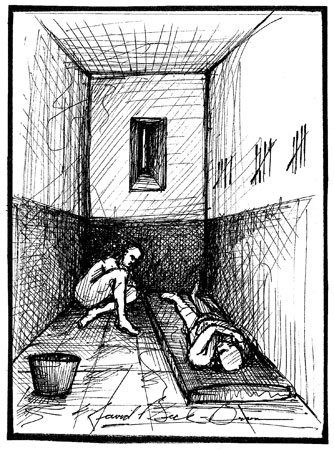
(Political Cartoon by David Beck-Brown)
An Argument for Funding California's Arts in
Corrections Program
By David Beck-Brown
A New PATH (Parents for Addiction Treatment and Healing) Newsletter
A convicted felon is arrested and incarcerated into a California state prison. Even though his conviction may be justified, he will be serving his prison sentence with fear, hatred and boredom. While imprisoned, he will learn unforgettable lessons, beginning with racism.
The first lessons in prison are simple, everyone in prison is either a “Mexican”, “white”, “Black” or an “other”, (we may now add “Asian” to this list). All Latinos are called "Mexican", even if they were born in Colombia, Chili, Cuba or elsewhere. (No exceptions in prison, they are “Mexican”.) The English (once exclusively known as Anglos) are grouped with Russians, Scots, Poles and so forth, and are known as “white” (spelled only with lower case letters). All “whites” are also exclusively known as Anglos. The third racial group is called “Black” (black is always capitalized when referring to African-Americans). Asians (whether or not they come from China, Taiwan, Japan, or Korea) are making inroads into our prison population. Until recently, Asians were called “other” (spelled in lower case letters).
Following this introductory lesson in racism, prisoners may experience the dangers of associating too closely with other inmates outside their designated racial group, as defined above. Associating with inmates outside your group may cause great bodily harm, if not death.
The second most commonly learned lesson in prison involves protecting oneself from physical assault. This may require cultivating friendships within one's racial group for the sole purpose of garnering the group's protection. This association may become a “clique” or a “gang”. Becoming a member of such a group will not come cheaply because the group will demand restitution (demonstrations of allegiance) in the form of favors. These favors are to be carried out without question. The group's protection and friendship will extend to assisting the new inmate in developing his tool-making skills. He will learn unique techniques for fabricating and concealing makeshift prison knives, or “shanks”. The group may also provide exercises in manipulating the judicial system, methods of committing successful crimes, and how to successfully laundry money. Most inmates learn subtle ways of psychologically isolating themselves from feeling emotional pain.
Ultimately, inmates will learn the law of “Cause and Effect” and that words have repercussions. Insulting another inmate with a casual remark, or even a look, could result in being “stuck” with a makeshift shank. Prison justice is always more severe than the crime. Inmates will learn the infamous prison mantra “I know nothing.” After serving several years in this environment, prisoners are released into the community. How will they conduct themselves as your new neighbor? Will they be different? What other lessons will they have learned in prison?
Arts in Corrections occupies the time and attention of the inmates participating in the program. The program is documented at reducing the inmate participant's violent behavior, destruction of state property and violent acts while incarcerated in prison. Inmates participating in the Arts in Corrections program self-monitor their own behavior. They do so because they want to retain the privilege of working in the program. Many of the Arts in Corrections inmate participants have become literary authors, successful sculptors, and so forth, from employing skills learned in the program. Upon release from prison, inmates participating in Arts in Corrections stay out of prison in greater proportions than inmates who do not participate in the program.
Because it rehabilitates prison inmates, Arts in Corrections could be called a Behavior-Modification Program or a Riot-Prevention Program. Call it what you may, the bottom line is that Arts in Corrections saves taxpayer dollars by lowering inmate recidivism. It offers a positive alternative to the criminal lessons available to them while incarcerated in our penal system.
|


